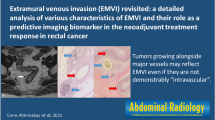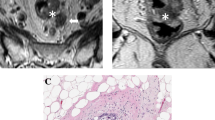Abstract
Objective
Extramural venous invasion (EMVI) is an independent prognostic factor for prediction of overall unfavorable outcomes in rectal cancer. While EMVI has traditionally been detected in postoperative pathologic specimens, MRI can provide this important piece of information preoperatively. This article reviews the methods of EMVI detection and their clinical implications for treatment and outcomes of rectal cancer.
Conclusion
EMVI has fundamental implications for rectal cancer prognosis and long-term outcomes. Since MRI has the advantage of preoperative detection of EMVI, it has been suggested that MRI-detected EMVI be incorporated for preoperative chemoradiotherapy (CRT) treatment stratification of rectal cancer for better patient triage and outcomes.





Similar content being viewed by others
References
Siegel RL, Miller KD, Fedewa SA, et al. (2017) Colorectal cancer statistics, 2017. CA Cancer J Clin 67:177–193. https://doi.org/10.3322/caac.21395
Kakar S, Shi C, Berho ME et al. (2017) Protocol for the examination of specimens from patients with primary carcinoma of the colon and rectum. Edition 4.0.0.1. http://www.cap.org/ShowProperty?nodePath=/UCMCon/Contribution%20Folders/WebContent/pdf/cp-colon-17protocol-4001.pdf
Howlader N, Noone AM, Krapcho M, Miller D, Bishop K, Altekruse SF, Kosary CL, Yu M, Ruhl J, Tatalovich Z, Mariotto A, Lewis DR, Chen HS, Feuer EJ, Cronin KA (2018) American Cancer Society. Cancer Facts & Figures 2018. https://www.cancer.org/cancer/colon-rectal-cancer/about/key-statistics.html
Bailey CE, Hu CY, You YN, et al. (2015) Increasing disparities in the age-related incidences of colon and rectal cancers in the United States, 1975-2010. JAMA Surg 150:17–22. https://doi.org/10.1001/jamasurg.2014.1756
Chand M, Bhangu A, Wotherspoon A, et al. (2014) EMVI-positive stage II rectal cancer has similar clinical outcomes as stage III disease following pre-operative chemoradiotherapy. Ann Oncol 25:858–863. https://doi.org/10.1093/annonc/mdu029
Sohn B, Lim J, Kim H, et al. (2015) MRI-detected extramural vascular invasion is an independent prognostic factor for synchronous metastasis in patients with rectal cancer. Eur Radiol 25:1347–1355. https://doi.org/10.1007/s00330-014-3527-9
Petersen VC, Baxter KJ, Love SB, Shepherd NA (2002) Identification of objective pathological prognostic determinants and models of prognosis in Dukes’ B colon cancer. Gut 51:65–69
Roxburgh CS, McMillan DC, Richards CH, et al. (2014) The clinical utility of the combination of T stage and venous invasion to predict survival in patients undergoing surgery for colorectal cancer. Ann Surg 259(6):1156–1165. https://doi.org/10.1097/SLA.0000000000000229
Huh JW, Lee JH, Kim HR, Kim YJ (2013) Prognostic significance of lymphovascular or perineural invasion in patients with locally advanced colorectal cancer. Am J Surg 206:758–763. https://doi.org/10.1016/j.amjsurg.2013.02.010
Horgan PG, McMillan DC (2010) Surgeons and selection of adjuvant therapy for node-negative colonic cancer. Br J Surg 97:1459–1460. https://doi.org/10.1002/bjs.7254
Van Wyk HC, Roxburgh CS, Horgan PG, Foulis AF, McMillan DC (2014) The detection and role of lymphatic and blood vessel invasion in predicting survival in patients with node negative operable primary colorectal cancer. Crit Rev Oncol Hematol 90:77–90. https://doi.org/10.1016/j.critrevonc.2013.11.004
Nougaret S, Reinhold C, Mikhael HW et al. (2013) The use of MR imaging in treatment planning for patients with rectal carcinoma: have you checked the “DISTANCE”? 268:330–44. https://doi.org/10.1148/radiol.13121361
Liu L, Liu M, Yang Z, He W, Wang Z (2016) Correlation of MRI-detected extramural vascular invasion with regional lymph node metastasis in rectal cancer. Clin Imaging. 40:456–460. https://doi.org/10.1016/j.clinimag.2016.01.007
Betge J, Pollheimer MJ, Lindtner RA, et al. (2012) Intramural and extramural vascular invasion in colorectal cancer: prognostic significance and quality of pathology reporting. Cancer 118:628–638. https://doi.org/10.1002/cncr.26310
Smith NJ, Barbachano Y, Norman AR, et al. (2008) Prognostic significance of magnetic resonance imaging-detected extramural vascular invasion in rectal cancer. Br J Surg 95:229–236
Smith N, Brown G (2008) Preoperative staging of rectal cancer. Acta Oncol 47:20–31. https://doi.org/10.1080/02841860701697720
McClelland D, Murray GI (2015) A comprehensive study of extramural venous invasion in colorectal cancer. PLoS ONE 10:e0144987. https://doi.org/10.1371/journal.pone.0144987
Howlett CJ, Tweedie EJ, Driman DK (2009) Use of an elastic stain to show venous invasion in colorectal carcinoma: a simple technique for detection of an important prognostic factor. J Clin Pathol. 62:1021–1025. https://doi.org/10.1136/jcp.2009.065615
Vass DG, Ainsworth R, Anderson JH, Murray D, Foulis AK (2004) The value of an elastic tissue stain in detecting venous invasion in colorectal cancer. J Clin Pathol 57:769–772. https://doi.org/10.1136/jcp.2003.015826
Smith NJ, Shihab O, Arnaout A, Swift RI, Brown G (2008) MRI for detection of extramural vascular invasion in rectal cancer. AJR Am J Roentgenol 191:1517–1522. https://doi.org/10.2214/AJR.08.1298
Brown G, Radcliffe AG, Newcombe RG, et al. (2003) Preoperative assessment of prognostic factors in rectal cancer using high-resolution magnetic resonance imaging. Br J Surg 90:355–364. https://doi.org/10.1002/bjs.4034
Jhaveri KS, Hosseini-Nik H, Thipphavong S, et al. (2016) MRI detection of extramural venous invasion in rectal cancer: correlation with histopathology using elastin stain. AJR Am J Roentgenol 206:747–755. https://doi.org/10.2214/AJR.15.15568
Siddiqui MRS, Simillis C, Hunter C, et al. (2017) A meta-analysis comparing the risk of metastases in patients with rectal cancer and MRI-detected extramural vascular invasion (mrEMVI) vs mrEMVI-negative cases. Br J Cancer 116:1513–1519. https://doi.org/10.1038/bjc.2017.99
MERCURY Study Group (2006) Diagnostic accuracy of preoperative magnetic resonance imaging in predicting curative resection of rectal cancer: prospective observational study. BMJ 333(7572):779. https://doi.org/10.1136/bmj.38937.646400.55
Chand M, Swift RI, Tekkis PP, Chau I, Brown G (2014) Extramural venous invasion is a potential imaging predictive biomarker of neoadjuvant treatment in rectal cancer. Br J Cancer 110:19–25. https://doi.org/10.1038/bjc.2013.603
Chand M, Siddiqui MR, Swift I, Brown G (2016) Systematic review of prognostic importance of extramural venous invasion in rectal cancer. World J Gastroenterol 22:1721–1726. https://doi.org/10.3748/wjg.v22.i4.1721
Bugg WG, Andreou AK, Biswas D, Toms AP, Williams SM (2014) The prognostic significance of MRI-detected extramural venous invasion in rectal carcinoma. Clin Radiol 69:619–623. https://doi.org/10.1016/j.crad.2014.01.010
Messenger DE, Driman DK, Kirsch R (2012) Developments in the assessment of venous invasion in colorectal cancer: implications for future practice and patient outcome. Hum Pathol 43:965–973. https://doi.org/10.1016/j.humpath.2011.11.015
Maas M, Lambregts DM, Lahaye MJ, et al. (2012) T-staging of rectal cancer: accuracy of 3.0 Tesla MRI compared with 1.5 Tesla. Abdom Imaging 37:475–481. https://doi.org/10.1007/s00261-011-9770-5
Donmez FY, Tunaci M, Yekeler E, et al. (2007) Effect of using endorectal coil in preoperative staging of rectal carcinomas by pelvic MR imaging. Eur J Radiol. 67:139–145. https://doi.org/10.1016/j.ejrad.2007.06.016
Beets-Tan RGH, Lambregts DMJ, Maas M, et al. (2018) Magnetic resonance imaging for clinical management of rectal cancer: Updated recommendations from the 2016 European Society of Gastrointestinal and Abdominal Radiology (ESGAR) consensus meeting. Eur Radiol 28:1465–1475. https://doi.org/10.1007/s00330-017-5026-2
Al-Sukhni E, Milot L, Fruitman M et al. (2015) User’s Guide for the Synoptic MRI Report for Pre-Operative Staging of Rectal Cancer. https://www.cancercareontario.ca/sites/ccocancercare/files/assets/CCOMRIRectalStagingUserGuide.pdf
Slater A, Halligan S, Taylor SA, Marshall M (2006) Distance between the rectal wall and mesorectal fascia measured by MRI: Effect of rectal distension and implications for preoperative prediction of a tumour-free circumferential resection margin. Clin Radiol. 61:65–70. https://doi.org/10.1016/j.crad.2005.08.010
Jhaveri KS, Hosseini-Nik H (2015) MRI of rectal cancer: an overview and update on recent advances. AJR Am J Roentgenol 205:W42–W55. https://doi.org/10.2214/AJR.14.14201
Chand M, Palmer T, Blomqvist L, et al. (2015) Evidence for radiologic and histopathologic prognostic importance of detecting EMVI in rectal cancer: recommendations for radiology and histopathology reporting. Color Dis 17:468–473. https://doi.org/10.1111/codi.12920
Chand M, Evans J, Swift RI, et al. (2015) The prognostic significance of post chemoradiotherapy high-resolution MRI and histopathology detected extramural venous invasion in rectal cancer. Ann Surg 261:473–479. https://doi.org/10.1097/SLA.0000000000000848
Patel UB, Brown G, Rutten H, et al. (2012) Comparison of magnetic resonance imaging and histopathological response to chemoradiotherapy in locally advanced rectal cancer. Ann Surg Oncol 19:2842–2852. https://doi.org/10.1245/s10434-012-2309-3
Wu CC, Lee RC, Chang CY (2013) Prediction of lymphovascular invasion in rectal cancer by preoperative CT. AJR Am J Roentgenol 201:985–992. https://doi.org/10.2214/AJR.12.9657
Talbot IC, Ritchie S, Leighton M, et al. (1981) Invasion of veins by carcinoma of rectum: method of detection, histological features and significance. Histopathology 5:141–163
Roxburgh CS, McMillan DC, Anderson JH, et al. (2010) Elastica staining for venous invasion results in superior prediction of cancer-specific survival in colorectal cancer. Ann Surg 252:989–997. https://doi.org/10.1097/SLA.0b013e3181f1c60d
Maughan NJ, Morris E, Forman D, Quirke P (2007) The validity of the Royal College of Pathologists’ colorectal cancer minimum dataset within a population. Br J Cancer 97:1393–1398. https://doi.org/10.1038/sj.bjc.6604036
Knijn N, van Exsel UEM, de Noo ME, Nagtegaal ID (2017) The value of intramural vascular invasion in colorectal cancer - a systematic review and meta-analysis. Histopathology. https://doi.org/10.1111/his.13404
Loughrey MB, Shepherd NA (2014) Standards and datasets for reporting cancers dataset for colorectal cancer histopathology reports July 2014. https://www.rcpath.org/asset/E94CE4A2-D722-44A7-84B9D68294134CFC/
Kirsch R, Assarzadegan N, Messenger DE, et al. (2017) The impact of knowledge transfer on the detection of venous invasion in colorectal cancer. Hum Pathol. 67:45–53. https://doi.org/10.1016/j.humpath.2017.07.004
Messenger DE, Driman DK, McLeod RS, Riddell RH, Kirsch R (2011) Current practice patterns among pathologists in the assessment of venous invasion in colorectal cancer. J Clin Pathol 64:983–989
Kirsch R, Messenger DE, Riddell RH, et al. (2013) Venous invasion in colorectal cancer: impact of an elastin stain on detection and interobserver agreement among gastrointestinal and nongastrointestinal pathologists. Am J Surg Pathol 37:200–210. https://doi.org/10.1097/PAS.0b013e31826a92cd
Vass DG, Ainsworth R, Anderson JH, Murray D, Foulis AK (2004) The value of an elastic tissue stain in detecting venous invasion in colorectal cancer. J Clin Pathol 57:769–772. https://doi.org/10.1136/jcp.2003.015826
Minsky B, Mies C (1989) The clinical significance of vascular invasion in colorectal cancer. Dis Colon Rectum 32:794–803
Abdulkader M, Abdulla K, Rakha E, Kaye P (2006) Routine elastic staining assists detection of vascular invasion in colorectal cancer. Histopathology 49:487–492. https://doi.org/10.1111/j.1365-2559.2006.02533.x
Dawson H, Kirsch R, Driman DK, et al. (2015) Optimizing the detection of venous invasion in colorectal cancer: the ontario, Canada, experience and beyond. Front Oncol 4:354. https://doi.org/10.3389/fonc.2014.00354
Littleford SE, Baird A, Rotimi O, Verbeke CS, Scott N (2009) Interobserver variation in the reporting of local peritoneal involvement and extramural venous invasion in colonic cancer. Histopathology 55:407–413. https://doi.org/10.1111/j.1365-2559.2009.03397.x
Sternberg A, Mizrahi A, Amar M, Groisman G (2006) Detection of venous invasion in surgical specimens of colorectal carcinoma: the efficacy of various types of tissue blocks. J Clin Pathol 59:207–210. https://doi.org/10.1136/jcp.2004.023333
Brown CE, Warren S (1938) Visceral metastases from rectal carcinoma. Surg Gynecol Obstetr 66:611–621
Benson AIB, Venook AP, AL-Hawary MM et al (2017) NCCM clinical practice guidelines in oncology (NCCN guidelines) version 4.2017-january 18, 2018 https://www.nccn.org/professionals/physician_gls/pdf/rectal.pdf
Chand M, Swift RI, Chau I, et al. (2014) Adjuvant therapy decisions based on magnetic resonance imaging of extramural venous invasion and other prognostic factors in colorectal cancer. Ann R Coll Surg Engl 96:543–546. https://doi.org/10.1308/003588414X13814021678835
Author information
Authors and Affiliations
Corresponding author
Ethics declarations
Funding
N/A
Disclosure of potential conflicts of interest
None.
Research involving human participants and/or animals
This article does not contain any studies with human participants or animals performed by any of the authors.
Informed consent
N/A
Rights and permissions
About this article
Cite this article
Ale Ali, H., Kirsch, R., Razaz, S. et al. Extramural venous invasion in rectal cancer: overview of imaging, histopathology, and clinical implications. Abdom Radiol 44, 1–10 (2019). https://doi.org/10.1007/s00261-018-1673-2
Published:
Issue Date:
DOI: https://doi.org/10.1007/s00261-018-1673-2




